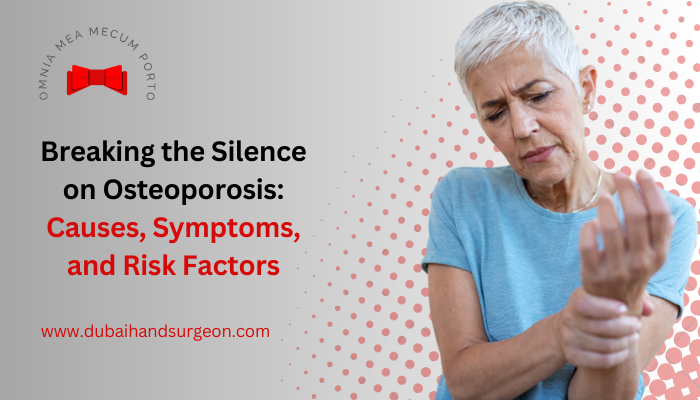
Breaking the Silence on Osteoporosis: Causes, Symptoms, and Risk Factors

Breaking the Silence on Osteoporosis: Causes, Symptoms, and Risk Factors
Osteoporosis is a condition that affects a lot of people around the world, especially older women. It causes bones to become weak, increasing the risk of fractures and injuries.
Osteoporosis may sound scary, but it does not have to be. With the proper knowledge, attitude, and action, you can prevent or manage osteoporosis and enjoy a high quality of life.
In this blog, I will show you how to do that by addressing osteoporosis causes and symptoms and how to treat them. So, let’s start this journey together and make osteoporosis a thing of the past.

What is Osteoporosis?
Your bones are constantly changing as old bone is removed and new bone is formed. Osteoporosis happens when the new bone cannot keep up with the old bone loss.
It is a condition that affects your bones, making them weak and brittle. It increases the risk of fractures in the hip, wrist, or spine. You may not notice any symptoms until you break a bone, which can be very painful.
What Causes Osteoporosis?
Your bones are like sponges inside, with many tiny holes. Osteoporosis makes these holes bigger and more numerous, making your bones less solid and more fragile. Your bones protect and support your vital organs and store calcium and other minerals that your body needs. Your body constantly removes old bone and makes new bone. This process, called “bone remodelling,” keeps your bones strong and gives your body calcium.
You usually build more bone than you lose until you are about 30 years old. After 35, you start to lose more bone than you make. This makes your bones thinner and weaker. Osteoporosis causes this bone loss to speed up.
Your risk of getting osteoporosis depends on how much bone you had when you were young. This is called peak bone mass. It is different for each race and partly genetic. The more bone you had, the lower your risk of osteoporosis as you get older.
Common Risk Factors:
Many factors can cause or increase the risk of osteoporosis, such as:
- Age: Your bones become thinner and weaker as you get older.
- Sex: It is more common in women than men, especially after menopause.
- Family history: If your parents or siblings have osteoporosis, you are more likely to inherit it.
- Diet: Not getting enough vitamin D and calcium can affect your bone health.
- Lifestyle: Drinking too much alcohol, Smoking, and being inactive can harm your bones.
- Medications: Some drugs, such as corticosteroids, can interfere with bone formation or increase bone loss.
- Diseases: Certain conditions, such as rheumatoid arthritis, hyperthyroidism, and celiac disease, can affect your bone metabolism.
Osteoporosis Symptoms
Osteoporosis does not have any Signs or symptoms until a bone breaks. The most common bones to break are in your hip, wrist, and spine. Some Signs and symptoms of osteoporosis that you may have include:
- Loss of height over time.
- A stooped posture.
- Back pain, due to a broken or collapsed bone in the spine.
- A bone that breaks much more easily than expected.
Prof Dr Robert Hierner emerges as a top-notch hand specialist and rheumatoid arthritis doctor in Dubai, offering comprehensive evaluations and recommending effective treatment methods for osteoporosis.
How to Treat Osteoporosis?
Treatment of osteoporosis depends on your risk of breaking a bone, your age, gender and medical history.
Some of the common treatments for osteoporosis are:
Medications
Medications can slow down the breakdown of bone, such as bisphosphonates, denosumab, and hormone therapy. These medications help to maintain bone density and lower the risk of fracture, particularly of the hip, spine, and wrist.
Supplements of calcium and vitamin D
Calcium helps to build and strengthen bones, while vitamin D helps the body absorb calcium and regulate bone metabolism. You can have calcium and vitamin D from your diet, pills, or liquids.
Exercise
Exercise, especially weight-bearing and resistance exercises, can improve your muscle strength, balance, and posture. You should aim for at least 30 minutes of moderate exercise on most days of the week and include both weight-bearing and resistance exercises in your routine.
Prevention of falls
Falls are a significant cause of broken bones in people with osteoporosis, especially in older people. To prevent falls, you should wear shoes that fit well and have good traction, use a cane, walker, or handrail if needed, and make sure your home is well-lit and free of clutter, loose rugs, cords, or slippery surfaces.
Consult Prof Dr Robert Hierner for Osteoporosis in Dubai
If you are looking for a reliable and experienced doctor to treat your osteoporosis, look no further than Prof Dr Robert Hierner. He is a German board-certified hand surgeon who specialises in the diagnosis and treatment of osteoporosis and other bone and joint disorders.
Prof Dr Robert can help you prevent fractures, improve your bone density, and restore your mobility and quality of life.
Don’t let osteoporosis hold you back. Consult Prof Dr Robert Hierner for Osteoporosis in Dubai today and get the best care for your bones.

 العربية
العربية 
